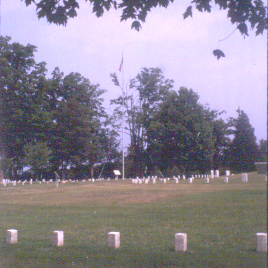
National Cemeteries
The Department of Veterans Affairs maintains 114 National Cemeteries in thirty-eight states and Puerto Rico (as well as thirty-three “soldiers’ lots” and monument sites). Five cemeteries are in Tennessee: Chattanooga National Cemetery, Mountain Home National Cemetery, Knoxville National Cemetery, Nashville National Cemetery, and Memphis National Cemetery. The Department of Interior also maintains several cemeteries at various historic sites in Tennessee, including Fort Donelson National Battlefield, Shiloh National Military Park, Stones River National Battlefield, and the Andrew Johnson National Historic Site.
The idea for creating national cemeteries emerged in the midst of the Civil War. President Abraham Lincoln signed legislation authorizing the creation of national cemeteries on July 17, 1862, “for the soldiers who shall die in service of the country.” After the war recovery teams disinterred roughly 250,000 remains from makeshift burial sites. By 1870 these had been concentrated in seventy-three national cemeteries.
Eligibility for burial in national cemeteries has gradually expanded to include all veterans of the United States armed forces, except those dishonorably discharged. American war veterans of allied armed forces–such as the American pilots who flew with the British Royal Air Force prior to American entry into World War II and the “Flying Tigers” who flew under Chinese command–and veterans’ spouses and dependent children, as well as members of the reserve forces who died in training or on active duty or amassed twenty years of service are also eligible for burial in national cemeteries. The federal government provides headstones and markers.
More than seventy thousand burials take place each year in Department of Veterans Affairs cemeteries. This number has been increasing steadily and will likely continue into the twenty-first century due to the large number of World War II veterans. Two Tennessee cemeteries, Chattanooga and Mountain Home, remain “open” for burials. The other three Veterans Affairs cemeteries and the Department of Interior cemeteries are no longer accepting new internments. They do make allowances, however, for spouses and children and accept cremated remains.
All national cemeteries, of course, have interesting local histories in addition to their famous and not-so-famous internees. Fort Donelson, arguably the most diverse cemetery, is home to veterans of seven different wars. Shiloh’s moss-covered walls serenely surround thousands of unidentified graves. Chattanooga National Cemetery, founded on November 26, 1863, the day after the battle of Missionary Ridge, offers a good example of the history associated with these places. When Union General George Thomas, who personally supervised many aspects of the internment, was asked if he wanted the men buried according to their states, as had been the custom, he replied, “No, no; mix ’em up, mix ’em up; I’m tired of states’ rights!” (1)
Chattanooga’s most famous internees are likely James Andrews and seven of his men. After they stole a locomotive near Kennesaw, Georgia, Confederate forces pursued and captured the raiders near Ringgold, in what came to be known in Civil War legend as the “Great Locomotive Chase.” All eight were later hanged in Atlanta. All the men, except the civilian Andrews, received Congressional Medals of Honor and were among the first to be awarded this honor. Chattanooga is also the final resting place of Medal of Honor winners from World War II and the Korean War.



